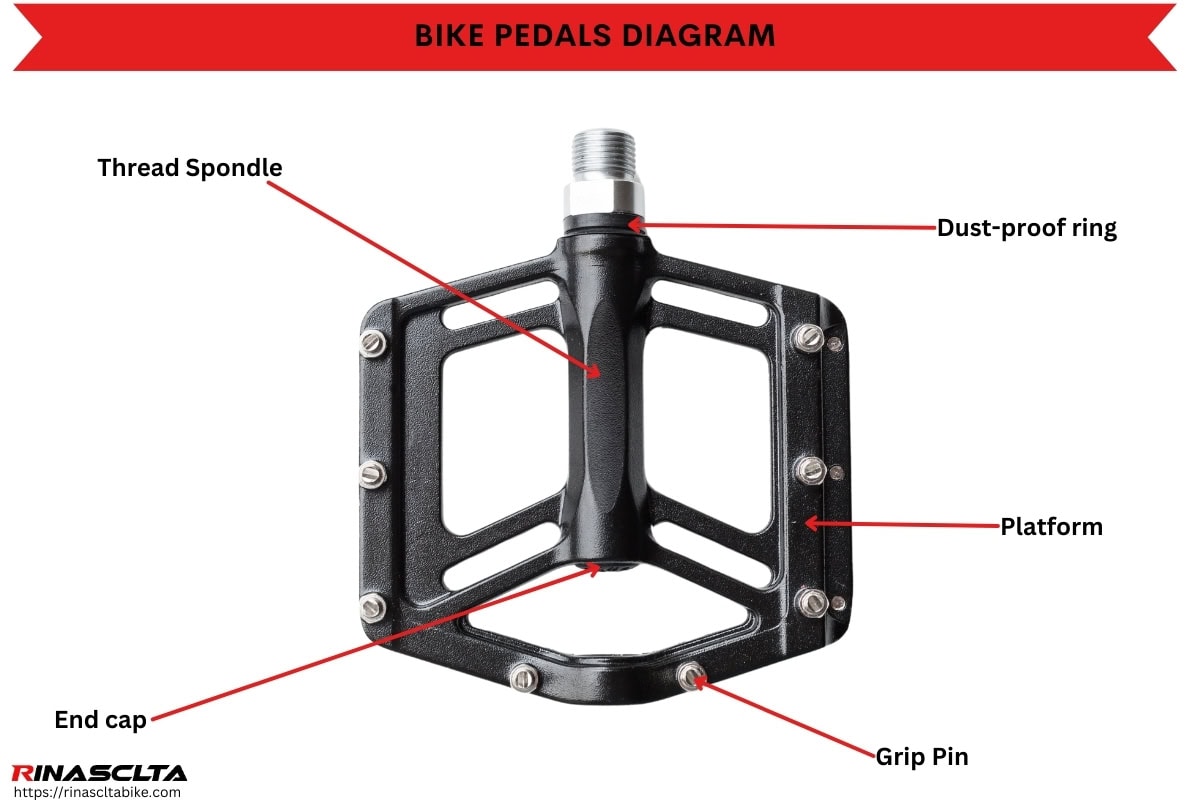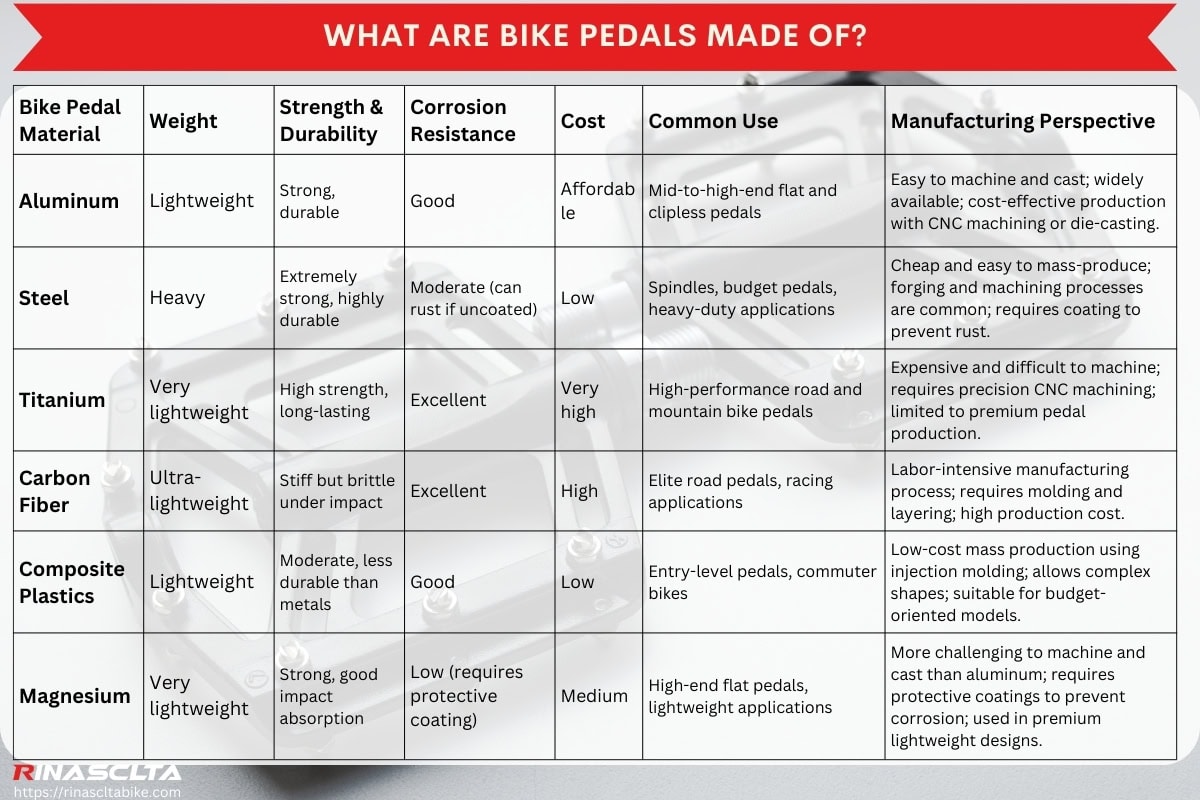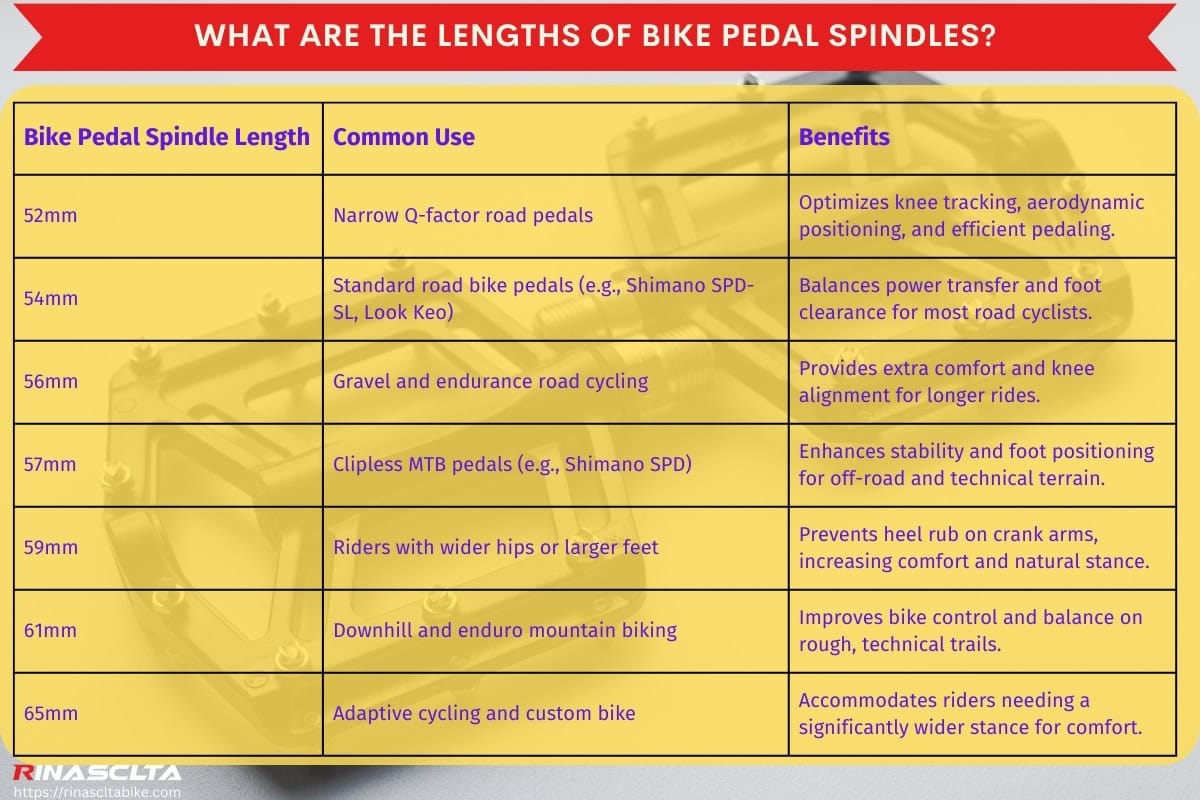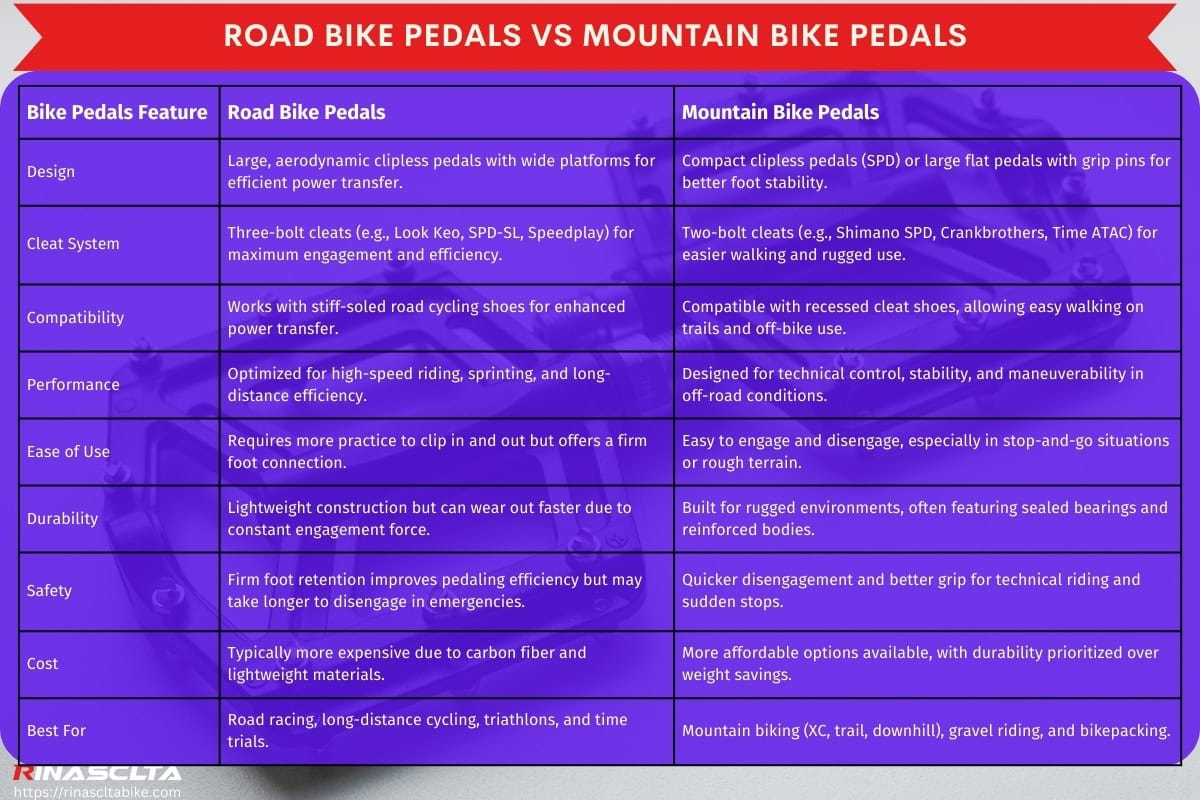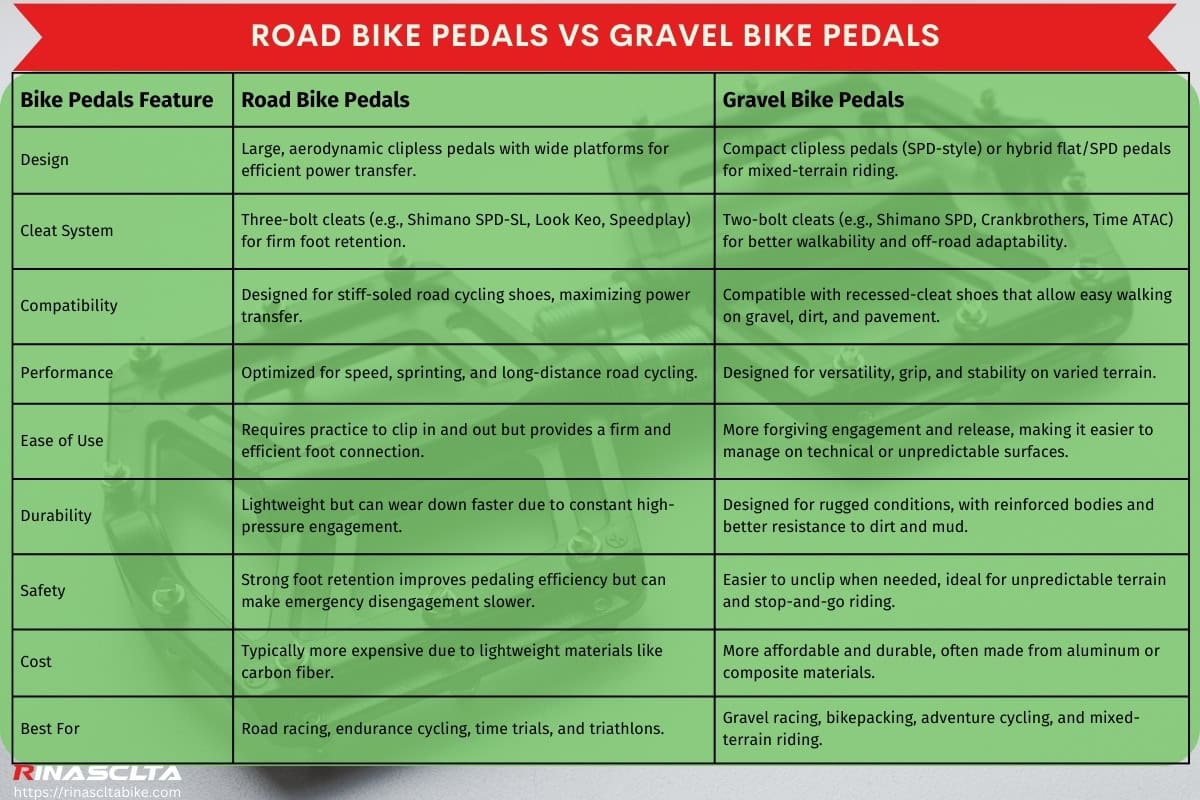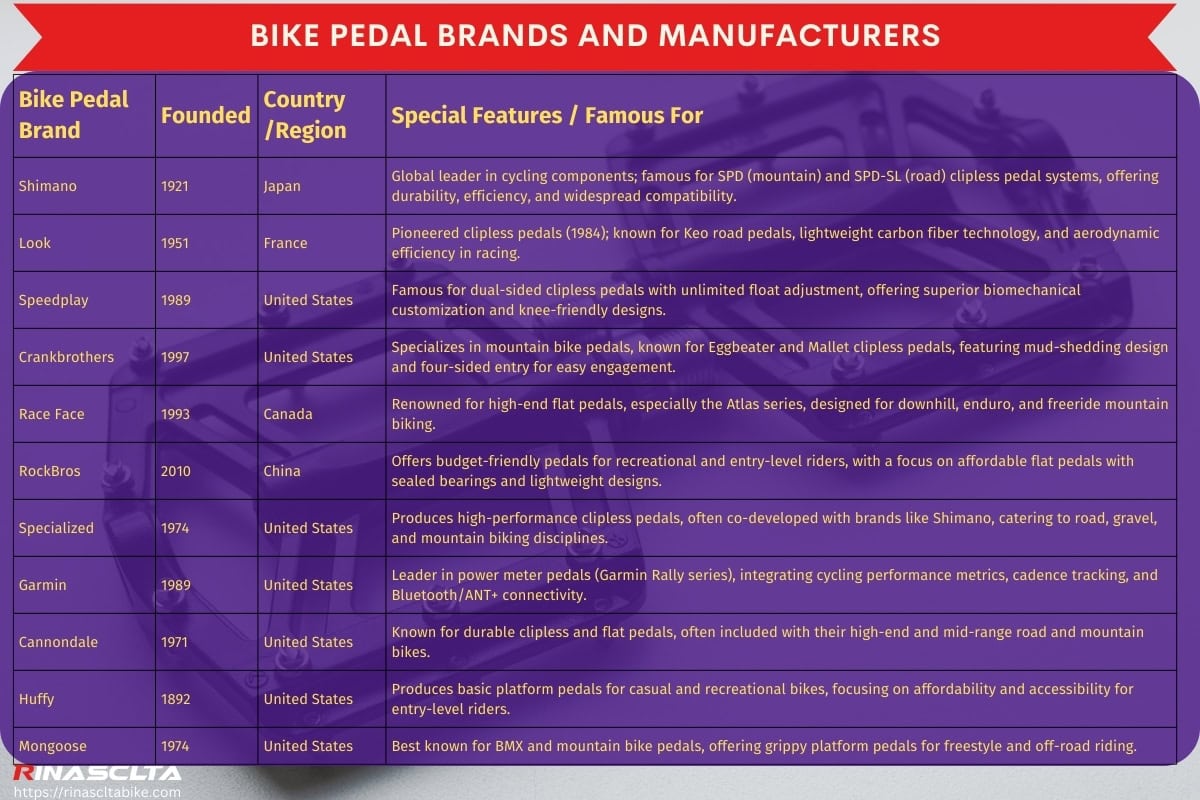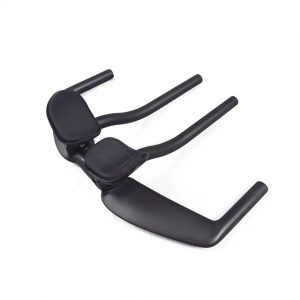Bike pedals are one of the most essential contact points between the rider and the bicycle, directly influencing power transfer, efficiency, and control. Evolving from simple flat platforms in the late 19th century to modern clipless systems, pedals come in various types such as flat, clipless, and hybrid, designed for different riding disciplines like road cycling, mountain biking, commuting, and BMX. Constructed from materials like aluminum, steel, titanium, and composite plastics, pedals are engineered for durability, weight optimization, and grip performance. Standardized spindle sizes, typically 9/16 inch (14.3 mm) or 1/2 inch (12.7 mm), ensure compatibility across most cranksets, while international standards like ISO 4210 regulate their strength and safety. Whether using clipless pedals with cleats for maximum efficiency or flat pedals for versatility and maneuverability, choosing the right pedal type significantly impacts riding comfort, pedaling efficiency, and overall bike performance.
This article explores everything you need to know about bike pedals, including their definition, materials, types, standard sizes, and how to choose and use them for optimal power transfer, efficiency, and control across different cycling disciplines.
Table of Contents
What are bike pedals?
The bike pedals are the mechanical components that transfer power from the rider’s legs to the drivetrain, allowing the bicycle to move forward. The term “pedal” originates from the Latin word “pedalis,” meaning “of the foot,” as it is the contact point where the rider applies force to propel the bike. First introduced in the early 1860s by Pierre Michaux in France as part of the Velocipede, pedals evolved from simple wooden cranks attached directly to the front wheel to cottered and cotterless spindle designs by the late 19th century.
By the 1970s, brands like Campagnolo, Shimano, and Look began refining pedal systems, leading to the development of clipless pedals in 1984 by Look Cycle (France), inspired by ski-binding technology. Today, bike pedals come in multiple types, including flat/platform pedals for BMX and casual riders, clipless pedals for road and mountain bikers seeking maximum power efficiency, and hybrid pedals that combine both features. With standard 9/16-inch (14.3 mm) and 1/2-inch (12.7 mm) spindle sizes, modern pedals are made from materials like aluminum, steel, titanium, and carbon composite to balance durability, weight, and performance across different cycling disciplines.
How do bike pedals work?
Bike pedals function as the primary interface between the rider’s feet and the bicycle, converting downward force from the legs into rotational energy that drives the crank arms, turning the chainring and propelling the bike forward. Designed for efficiency and control, flat pedals provide a stable platform for casual riding and technical maneuvering, while clipless pedals, first popularized by Bernard Hinault in the 1985 Tour de France using Look’s ski-binding-inspired system, lock the rider’s shoes into place for improved power transfer (up to 30% more efficiency), stability, and cadence consistency, especially on road, mountain, gravel, and track bikes across varying terrains.
What are flat bike pedals?
Flat bike pedals are platform-style pedals that provide a wide, stable surface for the rider’s foot without requiring any special cleats or attachments, allowing for easy foot placement and quick disengagement. Originally the standard design since the 1860s Velocipede era, flat pedals evolved significantly in the 1970s and 1980s with brands like Shimano, Wellgo, and Race Face refining materials and grip technology to enhance performance, particularly for BMX, mountain biking (MTB), downhill, urban commuting, and touring.
Designed with metal or composite platforms, replaceable grip pins, and sealed bearings for durability, flat pedals cater to riders who prioritize maneuverability, quick foot adjustment, and technical control, especially on rough terrain and technical descents. The popularity of flat pedals remains strong among freestyle riders, downhill racers, and casual cyclists, offering a balance between comfort, versatility, and bike handling precision without the commitment of clipless engagement systems.
What are clipless bike pedals?
Clipless bike pedals are a pedal system that locks the rider’s shoes into place using a cleat-and-binding mechanism, ensuring efficient power transfer, stability, and pedaling consistency. Despite the name, “clipless” refers to the absence of traditional toe clips and straps, which were replaced in 1984 when Look Cycle (France), inspired by ski bindings, introduced the first commercial clipless pedals, famously used by Bernard Hinault in the 1985 Tour de France.
Designed with spring-loaded retention systems, adjustable release tension, and lightweight materials like carbon fiber and titanium, clipless pedals maximize energy efficiency (up to 30% more power transfer) and provide a secure connection, making them ideal for road cycling, mountain biking (MTB), gravel, and time trials. Popular models from Shimano (SPD, SPD-SL), Look (Keo), Crankbrothers, and Time dominate the market, with systems tailored for road riders seeking optimal pedaling efficiency and mountain bikers needing mud-shedding capabilities. Although they require a learning curve, clipless pedals remain the preferred choice for competitive and endurance cyclists due to their biomechanical efficiency and improved pedaling dynamics.
How do bike shoes clip into pedals?
Bike shoes clip into pedals using a cleat-and-binding mechanism, where a metal or composite cleat attached to the shoe’s sole locks into the spring-loaded retention system of the clipless pedal, securing the rider’s foot for efficient power transfer and pedaling stability. Designed for biomechanical efficiency and safety, the system allows for adjustable release tension, enabling riders to disengage by rotating their heel outward, preventing accidental unclipping while ensuring quick foot release when needed. This mechanism, pioneered by Look Cycle in 1984 and refined by brands like Shimano (SPD/SPD-SL), Crankbrothers, and Time, improves cadence control, energy conservation, and rider confidence, making it the preferred choice for road, mountain, and gravel cycling.
Are bike pedals universal?
No, bike pedals are not universal because they come in different thread sizes, designs, and compatibility requirements based on the bike type and riding style. The most common thread size is 9/16 inch (14.3 mm) with 20 TPI (threads per inch), used on most modern bikes, but some older and lower-end bikes, like children’s bikes and certain BMX models, use a smaller 1/2 inch (12.7 mm) thread. Additionally, pedals are categorized into flat/platform, clipless, and hybrid designs, each requiring specific shoes and cleats, meaning they are not interchangeable without the proper setup.
Are mountain bike pedals universal?
No, mountain bike pedals are not universal because they come in flat and clipless designs, with different cleat standards and axle compatibility. Most modern MTB pedals use a 9/16 inch (14.3 mm) thread, but variations exist in spindle length and platform size, especially for downhill, enduro, and cross-country (XC) riding. Clipless MTB pedals, such as Shimano SPD, Crankbrothers, and Time ATAC, use 2-bolt cleat systems, which are incompatible with road bike cleats, further limiting universal compatibility.
Are road bike pedals universal?
No, road bike pedals are not universal because they primarily use clipless systems with different cleat designs and retention mechanisms, such as Shimano SPD-SL, Look Keo, and Speedplay, all of which have unique cleat shapes and engagement mechanisms. Road pedals also feature larger platforms for increased power transfer, making them distinct from MTB and hybrid pedals. Although most road pedals share the standard 9/16 inch (14.3 mm) thread, differences in stack height, float adjustment, and cleat compatibility prevent universal interchangeability between brands and bike types.
Bike pedals diagram
The bike pedal diagram visually represents the pedal structure, components, and mechanism, helping cyclists understand how different pedal types function and interact with the crank arm, spindle, bearings, and cleat system. This is important for choosing the right pedals, proper installation, maintenance, and troubleshooting issues like play or wear, ensuring optimal performance and riding efficiency.
What are the parts of bike pedals?
The parts of bike pedals include the spindle, bearings, pedal body, platform or cage, grip pins, cleat mechanism (for clipless pedals), dust-proof ring, end cap, and retention spring (for clipless systems), each contributing to durability, efficiency, and rider control. Each of these parts plays a crucial role in pedal performance, durability, and riding efficiency, whether for road cycling, mountain biking, or casual commuting.
- Spindle (Axle) – The metal shaft, usually 9/16 inch (14.3 mm) or 1/2 inch (12.7 mm) in diameter, that threads into the crank arm and allows the pedal to rotate.
- Bearings – Usually sealed cartridges or loose ball bearings, these reduce friction and enable smooth pedal rotation under load.
- Pedal Body – The main structure, which is made from aluminum, carbon, steel, or composite plastic, provides a stable platform for the foot.
- Platform (for Flat Pedals) – The wide, textured surface that enhances grip, often featuring replaceable metal pins for added traction.
- Grip Pins (on Flat Pedals) – Small threaded metal pins on the platform, which improve shoe grip, especially in mountain biking and BMX.
- Cleat Mechanism (for Clipless Pedals) – A spring-loaded binding system that locks a rider’s shoe cleat into place for efficient power transfer.
- Retention Spring (for Clipless Pedals) – A tension-adjustable spring that controls the cleat engagement and release mechanism.
- Dust-Proof Ring – A seal around the spindle and bearings that protects against dirt, mud, and moisture, extending pedal life.
- End Cap – A protective cap covering the outer edge of the spindle, providing bearing access for maintenance.
- Reflectors (on Some Pedals) – Safety components required on commuter and city bikes, enhancing visibility in low-light conditions.
What are bike pedals made of?
Bike pedals are made of materials such as aluminum, steel, titanium, carbon fiber, composite plastics, and magnesium, each chosen for its balance of strength, weight, cost, and durability to suit different cycling disciplines and rider preferences. These materials are selected based on factors like manufacturing efficiency, corrosion resistance, impact absorption, and performance characteristics, ensuring reliability across road, mountain, BMX, and commuter bikes. Each material is chosen based on the performance demands, budget, and longevity requirements of different riders, ensuring that bike pedals are optimized for strength, efficiency, and durability across all cycling disciplines.
- Aluminum – A lightweight and cost-effective material commonly used in mid-to-high-end flat and clipless pedals, offering excellent strength-to-weight ratio, corrosion resistance, and affordability.
- Steel – Known for its superior strength and durability, steel is used for spindles and bearings in pedals to withstand high loads and wear over time, though it adds more weight.
- Titanium – A premium material used in high-performance road and mountain bike pedals, offering exceptional strength, corrosion resistance, and weight savings, but at a significantly higher cost.
- Carbon Fiber – Found in elite-level road pedals, carbon fiber provides an ultra-lightweight construction, stiffness for power transfer, and aerodynamic advantages, making it ideal for racing applications.
- Composite Plastics – A budget-friendly and lightweight option used in entry-level and commuter pedals, composites offer impact resistance, affordability, and design flexibility, though they may wear out faster than metal alternatives.
- Magnesium – Valued for its lightweight properties and shock absorption, magnesium is used in some high-end flat pedals, providing a lighter alternative to aluminum with good strength, but requiring protective coatings to prevent corrosion.
| Bike Pedal Material | Weight | Strength & Durability | Corrosion Resistance | Cost | Common Use | Manufacturing Perspective |
| Aluminum | Lightweight | Strong, durable | Good | Affordable | Mid-to-high-end flat and clipless pedals | Easy to machine and cast; widely available; cost-effective production with CNC machining or die-casting. |
| Steel | Heavy | Extremely strong, highly durable | Moderate (can rust if uncoated) | Low | Spindles, budget pedals, heavy-duty applications | Cheap and easy to mass-produce; forging and machining processes are common; requires coating to prevent rust. |
| Titanium | Very lightweight | High strength, long-lasting | Excellent | Very high | High-performance road and mountain bike pedals | Expensive and difficult to machine; requires precision CNC machining; limited to premium pedal production. |
| Carbon Fiber | Ultra-lightweight | Stiff but brittle under impact | Excellent | High | Elite road pedals, racing applications | Labor-intensive manufacturing process; requires molding and layering; high production cost. |
| Composite Plastics | Lightweight | Moderate, less durable than metals | Good | Low | Entry-level pedals, commuter bikes | Low-cost mass production using injection molding; allows complex shapes; suitable for budget-oriented models. |
| Magnesium | Very lightweight | Strong, good impact absorption | Low (requires protective coating) | Medium | High-end flat pedals, lightweight applications | More challenging to machine and cast than aluminum; requires protective coatings to prevent corrosion; used in premium lightweight designs. |
What are the common bike pedal sizes?
The common bike pedal sizes include standard 9/16 inch (14.3 mm), 1/2 inch (12.7 mm), -3mm shorter axles, +4mm extended axles, and one-piece pedal designs, each chosen to fit different crankset standards, riding disciplines, and rider ergonomics. These sizes ensure proper compatibility with crank arms, improve riding comfort and efficiency, and accommodate different foot positions and bike geometries. These pedal sizes are standardized across the cycling industry to ensure compatibility, adjustability, and ergonomic efficiency, helping riders choose the best fit for comfort, power transfer, and injury prevention.
- Standard 9/16 inch (14.3 mm) Thread – The most common size for modern road, mountain, gravel, hybrid, and BMX bikes, designed to fit standard crank arms with 20 TPI (threads per inch), ensuring durability and compatibility.
- 1/2 inch (12.7 mm) Thread – Found on older and low-end bikes, especially children’s bikes, some BMX models, and department store bicycles, often made for one-piece cranksets.
- -3mm Shorter Axle Pedals – Designed for riders with narrower hips or those seeking a closer foot stance, improving biomechanical efficiency and knee alignment.
- +4mm Extended Axle Pedals – Used by riders who need more Q-factor (wider foot stance) for comfort, knee clearance, or improved stability on wider-bottom-bracket bikes.
- One-Piece Pedal Design – Found on vintage and budget bikes, where the pedal and crank arm are a single integrated unit, limiting customization but reducing manufacturing costs.
What are the lengths of bike pedal spindles?
The lengths of bike pedal spindles typically range from 52mm to 65mm, with common sizes including 52mm, 54mm, 56mm, 57mm, 59mm, 61mm, and 65mm, each chosen to accommodate different rider biomechanics, crank arm widths, and Q-factor (stance width). These spindle lengths help improve comfort, knee alignment, power transfer, and handling stability across different cycling disciplines.
| Bike Pedal Spindle Length | Common Use | Benefits |
| 52mm | Narrow Q-factor road pedals | Optimizes knee tracking, aerodynamic positioning, and efficient pedaling. |
| 54mm | Standard road bike pedals (e.g., Shimano SPD-SL, Look Keo) | Balances power transfer and foot clearance for most road cyclists. |
| 56mm | Gravel and endurance road cycling | Provides extra comfort and knee alignment for longer rides. |
| 57mm | Clipless MTB pedals (e.g., Shimano SPD) | Enhances stability and foot positioning for off-road and technical terrain. |
| 59mm | Riders with wider hips or larger feet | Prevents heel rub on crank arms, increasing comfort and natural stance. |
| 61mm | Downhill and enduro mountain biking | Improves bike control and balance on rough, technical trails. |
| 65mm | Adaptive cycling and custom bike | Accommodates riders needing a significantly wider stance for comfort. |
Types of bike pedals
The types of bike pedals are categorized based on cleat type (e.g., flat, clipless, strap-based, SPD, power meter pedals) and bike type (e.g., road, gravel, mountain (XC, DH, trail, enduro, trekking), city, exercise, stationary, Peloton, under-desk pedals). These bike pedal classifications reflect how different pedal designs influence power transfer, efficiency, foot retention, and compatibility with cycling disciplines, with clipless pedals optimizing pedaling mechanics for road and MTB, flat pedals prioritizing maneuverability and ease of use, and specialized pedals offering unique functions like power measurement and indoor cycling performance tracking.
Bike pedals sorted by cleat type
Bike pedals are categorized by cleat type into flat pedals, clipless pedals, pedals with straps, SPD pedals, and power meter pedals, each designed to optimize power transfer, foot retention, efficiency, and control based on the rider’s needs and cycling discipline. These classifications are essential because different pedal-cleat systems impact pedaling efficiency, comfort, and compatibility with shoes, affecting performance, cadence control, and muscle engagement across road cycling, mountain biking (MTB), commuting, and indoor training. These pedal types ensure riders maximize performance, stability, and comfort, whether for high-speed road racing, technical mountain biking, or efficient indoor training.
- Flat Pedals – Feature a wide, grippy platform with no cleat attachment, allowing easy foot placement and maneuverability, ideal for BMX, downhill MTB, freeride, and casual commuting.
- Clipless Pedals – Use a cleat-and-binding system (e.g., SPD, SPD-SL, Look Keo, Crankbrothers) to secure the foot for optimal power transfer, widely used in road cycling, mountain biking, and competitive racing.
- Pedals with Straps or Toe Clips – Feature an adjustable cage or strap system to hold the foot in place, commonly found in commuter bikes, track bikes, and vintage road bikes, providing some retention without requiring clipless shoes.
- SPD Pedals (Shimano Pedaling Dynamics) – A two-bolt clipless system designed for mountain biking, gravel riding, cyclocross, and commuting, offering easy engagement, walkable shoes, and efficient pedaling on rough terrain.
- Power Meter Pedals – Advanced pedals with built-in sensors to measure power output (watts), cadence, and pedaling efficiency, used by professional road cyclists and triathletes to track performance and training data with high precision.
What are the types of bike pedal clips?
The types of bike pedal clips are categorized into toe clips (with straps), SPD (Shimano Pedaling Dynamics), SPD-SL (road clipless), Look Keo, Crankbrothers, Time ATAC, Speedplay, and Peloton cleats, each designed for different cycling disciplines, foot retention mechanisms, and power transfer efficiency. These systems are classified based on cleat attachment method, engagement mechanism, release system, and intended bike type, ensuring optimized pedaling efficiency, stability, and comfort for road cyclists, mountain bikers, commuters, and indoor training riders.
Bike pedals sorted by bike type
Bike pedals are categorized by bike type into road, gravel (flat, enduro, adventure), mountain (XC, DH, trail, enduro, trekking), city, exercise, stationary, Peloton, and under-desk pedals, each designed to match the riding style, terrain demands, and efficiency needs of different cyclists. These classifications ensure optimal power transfer, comfort, and control, helping riders choose the right pedal system for performance, stability, and usability across various cycling disciplines.
- Road Bike Pedals – Use lightweight clipless systems like SPD-SL, Look Keo, and Speedplay, designed for maximum power transfer, aerodynamics, and efficient pedaling in high-speed road cycling.
- Gravel Bike Pedals (Flat, Enduro, Adventure) – Feature either clipless SPD systems for long-distance efficiency or flat pedals with grip pins for rough terrain control, balancing comfort and off-road versatility.
- Mountain Bike (XC, DH, Trail, Enduro, Trekking) Pedals – Available in clipless SPD (XC, trail, trekking) or large-platform flat pedals (DH, enduro) to provide stability, durability, and control on technical trails.
- City Bike Pedals – Typically flat or strap-based, offering ease of use, comfort, and compatibility with casual shoes for commuting and urban riding.
- Exercise Bike Pedals – Often dual-sided, with toe cages on one side and SPD compatibility on the other, allowing riders to train with either regular shoes or cycling cleats.
- Stationary Bike Pedals – Feature wide platforms with straps or clipless compatibility, ensuring foot stability and efficient power transfer for indoor workouts.
- Peloton Bike Pedals – Use Look Delta cleats, providing secure engagement and optimized pedaling mechanics for high-intensity indoor cycling.
- Under-Desk Bike Pedals – Compact, flat-style pedals with smooth resistance, designed for low-impact exercise while seated at a desk or in rehabilitation training.
Road bike pedals vs mountain bike pedals
Road bike pedals and mountain bike pedals are designed for different cycling environments, affecting efficiency, power transfer, compatibility, and ease of use. Road pedals prioritize lightweight construction, aerodynamics, and maximum power output, while mountain bike pedals emphasize durability, stability, and ease of engagement on rough terrain. Comparing these two types helps riders choose the best option based on riding style, performance needs, and comfort.
| Bike Pedals Feature | Road Bike Pedals | Mountain Bike Pedals |
| Design | Large, aerodynamic clipless pedals with wide platforms for efficient power transfer. | Compact clipless pedals (SPD) or large flat pedals with grip pins for better foot stability. |
| Cleat System | Three-bolt cleats (e.g., Look Keo, SPD-SL, Speedplay) for maximum engagement and efficiency. | Two-bolt cleats (e.g., Shimano SPD, Crankbrothers, Time ATAC) for easier walking and rugged use. |
| Compatibility | Works with stiff-soled road cycling shoes for enhanced power transfer. | Compatible with recessed cleat shoes, allowing easy walking on trails and off-bike use. |
| Performance | Optimized for high-speed riding, sprinting, and long-distance efficiency. | Designed for technical control, stability, and maneuverability in off-road conditions. |
| Ease of Use | Requires more practice to clip in and out but offers a firm foot connection. | Easy to engage and disengage, especially in stop-and-go situations or rough terrain. |
| Durability | Lightweight construction but can wear out faster due to constant engagement force. | Built for rugged environments, often featuring sealed bearings and reinforced bodies. |
| Safety | Firm foot retention improves pedaling efficiency but may take longer to disengage in emergencies. | Quicker disengagement and better grip for technical riding and sudden stops. |
| Cost | Typically more expensive due to carbon fiber and lightweight materials. | More affordable options available, with durability prioritized over weight savings. |
| Best For | Road racing, long-distance cycling, triathlons, and time trials. | Mountain biking (XC, trail, downhill), gravel riding, and bikepacking. |
Road bike pedals vs gravel bike pedals
Road bike pedals and gravel bike pedals are designed for different riding conditions, affecting efficiency, foot retention, comfort, and adaptability to terrain. Road pedals prioritize aerodynamics and maximum power transfer, while gravel pedals focus on versatility, durability, and ease of use on mixed surfaces. Comparing these two types helps cyclists determine the best choice based on riding style, terrain, and performance needs.
| Bike Pedals Feature | Road Bike Pedals | Gravel Bike Pedals |
| Design | Large, aerodynamic clipless pedals with wide platforms for efficient power transfer. | Compact clipless pedals (SPD-style) or hybrid flat/SPD pedals for mixed-terrain riding. |
| Cleat System | Three-bolt cleats (e.g., Shimano SPD-SL, Look Keo, Speedplay) for firm foot retention. | Two-bolt cleats (e.g., Shimano SPD, Crankbrothers, Time ATAC) for better walkability and off-road adaptability. |
| Compatibility | Designed for stiff-soled road cycling shoes, maximizing power transfer. | Compatible with recessed-cleat shoes that allow easy walking on gravel, dirt, and pavement. |
| Performance | Optimized for speed, sprinting, and long-distance road cycling. | Designed for versatility, grip, and stability on varied terrain. |
| Ease of Use | Requires practice to clip in and out but provides a firm and efficient foot connection. | More forgiving engagement and release, making it easier to manage on technical or unpredictable surfaces. |
| Durability | Lightweight but can wear down faster due to constant high-pressure engagement. | Designed for rugged conditions, with reinforced bodies and better resistance to dirt and mud. |
| Safety | Strong foot retention improves pedaling efficiency but can make emergency disengagement slower. | Easier to unclip when needed, ideal for unpredictable terrain and stop-and-go riding. |
| Cost | Typically more expensive due to lightweight materials like carbon fiber. | More affordable and durable, often made from aluminum or composite materials. |
| Best For | Road racing, endurance cycling, time trials, and triathlons. | Gravel racing, bikepacking, adventure cycling, and mixed-terrain riding. |
How do I know what pedals fit my bike?
You can determine what pedals fit your bike by checking the crank arm thread size, which is typically 9/16 inch (14.3 mm) with 20 TPI (threads per inch) for most modern road, mountain, gravel, and hybrid bikes, or 1/2 inch (12.7 mm) for some BMX and older department-store bikes, ensuring compatibility with your crankset. Additionally, consider your riding style and cleat system—clipless pedals (SPD, SPD-SL, Look Keo) require matching cycling shoes with compatible cleats, while flat pedals work with any footwear. Checking your crank arm material, Q-factor (stance width), and intended terrain helps you choose the right spindle length and pedal platform size for optimal performance, comfort, and efficiency.
How to choose bike pedals?
To choose the right bike pedals, you need to consider your riding style, whether you prefer clipless or flat pedals, and the type of cycling shoes you plan to use, ensuring compatibility with your bike type, terrain, and performance goals. These factors determine pedaling efficiency, foot retention, comfort, and control, helping you select the best pedal system for your needs.
- What is Your Riding Style?
- Mountain Biking (MTB) – Requires clipless SPD pedals for cross-country (XC) efficiency or large-platform flat pedals for downhill (DH) and enduro riding, prioritizing stability, durability, and grip.
- Recreational Biking – Best suited for flat pedals or hybrid clipless options, offering easy foot placement and comfort for casual or fitness riding.
- Bike Commuting – Hybrid pedals with SPD on one side and a flat platform on the other allow versatility, making it easy to switch between casual shoes and clip-in cycling shoes.
- Road Cycling – Road riders benefit from lightweight, aerodynamic clipless pedals (SPD-SL, Look Keo, Speedplay) that provide maximum power transfer and pedaling efficiency.
- Hybrid Clipless Pedals – Ideal for riders who want the benefits of both systems, allowing you to ride clipped-in for efficiency or use flat pedals for short commutes or technical sections.
- Clipless or Flat Pedals?
- Flat Pedals – Provide a large surface area and grip pins, making them perfect for BMX, downhill, freeride MTB, and casual cycling, where quick foot repositioning is essential.
- Clipless Pedals – Offer secure foot retention and better energy transfer, improving cadence control, sprinting, and climbing efficiency, ideal for road, MTB, and endurance riding.
- Type of Cycling Shoes
- Flat Pedal Shoes – Feature grippy rubber soles (e.g., Five Ten MTB shoes) that increase traction and stability for trail and downhill riders.
- Clipless Road Shoes – Designed with stiff carbon or composite soles for maximum power efficiency, compatible with three-bolt cleat systems (SPD-SL, Look Keo, Speedplay).
- Clipless MTB Shoes – Use two-bolt cleat systems (SPD, Crankbrothers, Time ATAC) with recessed cleats for easy walking, making them great for gravel, touring, and enduro riding.
How to install a bike pedals?
To install bike pedals, first, identify the left and right pedals (marked with “L” and “R” on the spindle) and apply grease or anti-seize compound to the pedal threads to prevent seizing. Thread the right pedal clockwise into the right crank arm and the left pedal counterclockwise into the left crank arm, using a 15mm pedal wrench or an 8mm Allen key to tighten them to the recommended torque (30-40 Nm) while ensuring they are securely fastened but not over tightened.
How to change bike pedals?
To change bike pedals, first, shift the chain onto the largest chainring to protect yourself from chainring teeth, then use a 15mm pedal wrench or an 8mm Allen key to loosen the old pedals (right pedal loosens counterclockwise, left pedal loosens clockwise). Once removed, clean the crank arm threads, apply grease to the new pedal threads, and carefully thread them in—right pedal clockwise, left pedal counterclockwise—before tightening to 30-40 Nm torque for a secure fit.
How to remove bike pedals?
To remove bike pedals, position the crank arm parallel to the ground for better leverage, and use a 15mm pedal wrench or an 8mm Allen key to turn the right pedal counterclockwise and the left pedal clockwise. If the pedals are stuck, apply penetrating oil (e.g., WD-40) to the threads, wait a few minutes, and use steady pressure to loosen them without stripping the crank arm threads.
How to take off bike pedals?
To take off the bike pedals, stabilize the bike on a repair stand or against a wall, position the crank arms for optimal leverage, and use a pedal wrench or Allen key to unscrew the pedals in the correct direction (right pedal counterclockwise, left pedal clockwise). Be mindful of thread direction and applied force, and after removal, clean and inspect the crank arm threads to prevent wear or damage before reinstalling or replacing the pedals.
What is the bike pedal thread direction?
The bike pedal thread direction follows a right-hand (clockwise) thread for the right pedal and a left-hand (counterclockwise) thread for the left pedal, ensuring that both pedals self-tighten during pedaling rather than loosening over time. This design, known as the precession effect, takes advantage of rotational forces to keep the pedals securely fastened to the crank arms, preventing accidental loosening due to continuous pedaling motion. The right pedal (marked “R”) threads clockwise, while the left pedal (marked “L”) threads in counterclockwise, a standard implemented to improve safety, durability, and rider efficiency across all types of bicycles.
Are bike pedals reverse threaded?
No, bike pedals are not entirely reverse threaded because only the left pedal has a left-hand (reverse) thread, while the right pedal follows a standard right-hand thread. This design, based on the precession effect, ensures that pedaling motion naturally tightens the pedals instead of loosening them over time. The right pedal (marked “R”) threads in clockwise (right-hand thread), while the left pedal (marked “L”) threads in counterclockwise (left-hand thread or reverse thread) to prevent it from unscrewing due to rotational forces. This standardization applies across most bicycles, ensuring durability, safety, and proper load distribution on crank arms.
What size wrench for bike pedals?
The wrench size for bike pedals is typically 15mm for standard pedal wrenches or 8mm Allen (hex) key for pedals with hexagonal spindle ends, ensuring a secure grip and proper torque application. The 15mm pedal wrench is designed with a thin profile and long handle to provide the necessary leverage for loosening or tightening pedals, while the 8mm Allen key is commonly used for modern clipless pedals that have an internal hex socket, allowing for easier access and a cleaner installation.
How to maintain bike pedals?
To maintain bike pedals, regularly clean them with a degreaser, inspect for wear on the bearings, spindle, and platform, and apply grease or lubrication to the pedal threads and bearings to prevent corrosion and ensure smooth rotation. Use a 15mm pedal wrench or 8mm Allen key to periodically remove the pedals, check for loose bearings, worn grip pins (for flat pedals), or excessive play in the spindle, and, if necessary, disassemble the pedals to regrease or replace sealed bearings or bushings, ensuring optimal performance and longevity.
Why does my bike pedal lose resistance?
Your bike pedal loses resistance because the internal bearings or bushings are worn out, lack lubrication, or have excessive play, reducing friction and making the pedal spin too freely. This happens when sealed cartridge bearings degrade over time, or when loose ball bearings inside cup-and-cone pedal systems become dry or misaligned due to dirt, moisture, or prolonged use. If the pedal has a bushing-based system, excessive wear on the bushing sleeve can also cause reduced resistance. Regular maintenance, regreasing, or replacing worn bearings can restore proper pedal function and ensure smooth, controlled rotation.
Why does my bike pedal lose resistance but fixes when I pedal backward?
Your bike pedal loses resistance but fixes when you pedal backward because the bearings inside the pedal or bottom bracket are unevenly worn, contaminated, or misaligned, causing inconsistent engagement when force is applied in one direction. This issue is often due to dirt or moisture inside the pedal bearings, which can create temporary binding or excessive play when pedaling forward, while pedaling backward redistributes the bearing load, momentarily restoring smoother movement. Additionally, in some sealed cartridge bottom brackets, uneven wear on the crank spindle or bearing races can create inconsistent drag, making the pedals feel loose when riding forward but temporarily stable when reversed. Regular bearing inspection, cleaning, and regreasing can help resolve this issue and maintain consistent pedal resistance.
What to do when my bike pedals with no tension?
If your bike pedals have no tension, inspect the bottom bracket, pedal bearings, and drivetrain components for wear, contamination, or misalignment, as worn-out bearings, a loose crankset, or a faulty freewheel mechanism can cause excessive play and loss of resistance. Check if the pedal bearings are dry or worn and regrease or replace them if necessary, ensure the crank arms are securely fastened to the spindle, and examine the freehub or freewheel mechanism to see if it is slipping instead of engaging properly, which may require cleaning, lubrication, or replacement to restore proper pedaling resistance.
Why does my bike make noise when pedaling?
Your bike makes noise when pedaling because components such as the pedals, bottom bracket, crank arms, chain, or cassette may be worn, loose, dry, or contaminated with dirt and debris, causing creaking, clicking, or grinding sounds. This happens when pedal bearings lack lubrication, the crankset or bottom bracket has excessive play, or the chain and cassette are misaligned or need lubrication, leading to friction and mechanical noise. To fix this, inspect and tighten the pedal threads (using a 15mm wrench or 8mm Allen key), lubricate the chain and cassette, check bottom bracket torque (typically 35–50 Nm), and ensure all drivetrain components are properly aligned and free of dirt, eliminating unnecessary noise and improving pedaling efficiency.
Why does my bike squeak when I pedal?
Your bike makes noise when pedaling because components such as the pedals, bottom bracket, crank arms, chain, or cassette may be worn, loose, dry, or contaminated with dirt and debris, causing creaking, clicking, or grinding sounds. This happens when pedal bearings lack lubrication, the crankset or bottom bracket has excessive play, or the chain and cassette are misaligned or need lubrication, leading to friction and mechanical noise. To fix this, inspect and tighten the pedal threads (using a 15mm wrench or 8mm Allen key), lubricate the chain and cassette, check bottom bracket torque (typically 35–50 Nm), and ensure all drivetrain components are properly aligned and free of dirt, eliminating unnecessary noise and improving pedaling efficiency.
Do you need to grease bike pedals?
Yes, you need to grease bike pedal because greasing bike pedals prevents seizing, reduces friction, and ensures smooth installation and removal from the crank arms. Pedal threads experience high torque and exposure to moisture, dirt, and debris, which can cause them to seize or corrode over time, making future removal difficult. Applying a thin layer of grease or anti-seize compound to the pedal threads before installation helps prevent galling (metal-on-metal sticking), makes maintenance easier, and extends the lifespan of both the pedal spindle and crank arm threads.
Should you grease bike pedal threads?
Yes, you should grease bike pedal threads because it prevents seizing, corrosion, and metal-on-metal binding, making pedal installation and removal easier. Pedal threads experience high torque and exposure to moisture, dirt, and temperature changes, which can cause them to seize in the crank arms over time, especially in aluminum or steel cranksets. Applying a thin layer of grease or anti-seize compound ensures smooth threading, reduces friction, prevents damage to the crank arms, and makes future maintenance hassle-free.
Can you ride an e-bike 28 mph without pedals?
Yes, you can ride an e-bike at 28 mph without pedals if it is a Class 3 e-bike with a throttle system capable of providing motor assistance up to that speed, but most Class 3 e-bikes in the U.S. are pedal-assist only (PAS) and require pedaling to reach 28 mph. Throttle-powered e-bikes without pedaling are typically limited to 20 mph (Class 2 e-bikes) due to legal restrictions, while some high-performance e-bikes or modified models can exceed 28 mph under throttle power alone, though this may make them legally classified as mopeds or motorized vehicles in certain regions.
How to use clipless bike pedals?
To use clipless bike pedals, you need cycling shoes with compatible cleats, proper pedal tension adjustment, and controlled engagement and disengagement techniques for safe and efficient riding. To clip in, position the front of the cleat into the pedal’s retention mechanism, apply downward pressure until you hear a click, ensuring the cleat is securely engaged for optimal power transfer. To clip out, rotate your heel outward to release the cleat from the pedal, practicing this motion at slow speeds or against a wall to build confidence and prevent unexpected falls.
How to clip in clipless bike pedals?
To clip into clipless bike pedals, align your shoe cleats with the pedal mechanism, apply downward pressure, and ensure a secure engagement for efficient pedaling. Position the front of the cleat into the pedal’s retention system, then press down firmly until you hear or feel a click, indicating the cleat is locked in place. Start with one foot clipped in while balancing, then push off and clip in the second foot smoothly, adjusting the pedal tension (if needed) for easier engagement.
How to unclip clipless bike pedals?
To unclip clipless bike pedals, rotate your heel outward to release the cleat from the pedal’s retention mechanism, ensuring a smooth and controlled disengagement. Shift your weight slightly onto the opposite foot, then apply outward pressure with your unclipping foot until you feel or hear a click, indicating the cleat has disengaged. Practice unclipping at slow speeds or while stationary against a wall to build confidence, and adjust pedal tension (if needed) to make releasing easier.
Bike pedal brands and manufacturers
Bike pedal brands and manufacturers play a crucial role in the cycling industry by innovating in performance, durability, efficiency, and ergonomics to meet the demands of different riding disciplines. Leading brands specialize in clipless road and mountain bike pedals, high-performance power meter pedals, durable flat pedals, and budget-friendly options for casual riders. These manufacturers contribute to the evolution of pedaling technology, ensuring optimal power transfer, comfort, and long-term reliability across various cycling disciplines, from competitive road racing and mountain biking to commuting and fitness cycling.
| Bike Pedal Brand | Founded | Country/Region | Special Features / Famous For |
| Shimano | 1921 | Japan | Global leader in cycling components; famous for SPD (mountain) and SPD-SL (road) clipless pedal systems, offering durability, efficiency, and widespread compatibility. |
| Look | 1951 | France | Pioneered clipless pedals (1984); known for Keo road pedals, lightweight carbon fiber technology, and aerodynamic efficiency in racing. |
| Speedplay | 1989 | United States | Famous for dual-sided clipless pedals with unlimited float adjustment, offering superior biomechanical customization and knee-friendly designs. |
| Crankbrothers | 1997 | United States | Specializes in mountain bike pedals, known for Eggbeater and Mallet clipless pedals, featuring mud-shedding design and four-sided entry for easy engagement. |
| Race Face | 1993 | Canada | Renowned for high-end flat pedals, especially the Atlas series, designed for downhill, enduro, and freeride mountain biking. |
| RockBros | 2010 | China | Offers budget-friendly pedals for recreational and entry-level riders, with a focus on affordable flat pedals with sealed bearings and lightweight designs. |
| Specialized | 1974 | United States | Produces high-performance clipless pedals, often co-developed with brands like Shimano, catering to road, gravel, and mountain biking disciplines. |
| Garmin | 1989 | United States | Leader in power meter pedals (Garmin Rally series), integrating cycling performance metrics, cadence tracking, and Bluetooth/ANT+ connectivity. |
| Cannondale | 1971 | United States | Known for durable clipless and flat pedals, often included with their high-end and mid-range road and mountain bikes. |
| Huffy | 1892 | United States | Produces basic platform pedals for casual and recreational bikes, focusing on affordability and accessibility for entry-level riders. |
| Mongoose | 1974 | United States | Best known for BMX and mountain bike pedals, offering grippy platform pedals for freestyle and off-road riding. |
